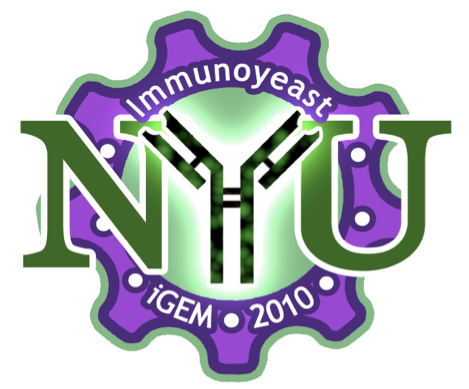Team:NYU/Project
From 2010.igem.org
(→Project Details) |
|||
| Line 13: | Line 13: | ||
{|align="right" | {|align="right" | ||
| - | | | + | |Many of the team's members have a strong interest in the field of immunology. Because of this we decided that the theme of our project would be to imitate the human immune system in yeast. Over the brainstorming sessions to follow our goal became to develop a strain that would be capable of determining if an antibody bound an antigen and could then process the antibody genes as in the differentiation of B cells. Our hope is to demonstrate the feasibility of using the yeast cell to not only discover antibodies but to provide a streamlined processing unit that can easily go from discovery to protein production. |
| + | |||
| + | |||
|[[Image:NYU_logo.png|200px|right|frame]] | |[[Image:NYU_logo.png|200px|right|frame]] | ||
|- | |- | ||
Revision as of 00:20, 3 September 2010
| Home | Team | Project | BioBricks | Modeling | Notebook | Safety |
|---|
| Many of the team's members have a strong interest in the field of immunology. Because of this we decided that the theme of our project would be to imitate the human immune system in yeast. Over the brainstorming sessions to follow our goal became to develop a strain that would be capable of determining if an antibody bound an antigen and could then process the antibody genes as in the differentiation of B cells. Our hope is to demonstrate the feasibility of using the yeast cell to not only discover antibodies but to provide a streamlined processing unit that can easily go from discovery to protein production.
| ||
| This part should serve as the official abstract describing the project. Unless the two paragraphs in the project details section below is the abstract? | File:NYU team.png Your team picture | |
Project Details
Our game plan for this year's competition is to construct an easy-to-use yeast strain capable of intracellular antibody discovery. The current dominant mode of antibody discovery using microbes requires cellular surface display and high-throughput fluorescent screening. Instead of using this method, we wanted our cells to be able to sense when the antibody they are translating will bind the target antigen. Using a modified form of the yeast two-hybrid screening system, the yeast cells will sense the amount of antibody::antigen interaction and will, in essence, screen themselves.
In a research setting, once you have discovered the antibody you wish to use you must then reclone the coding region into a secretion vector for production of pure antibody protein. To make this process faster and more easily accomplished, we are also building a recombination-based architecture into our system that will allow the cells to go straight from screening to protein production in a matter of minutes. This concept has the capability to not only shave weeks off of current antibody discovery protocols, but opens the door to programmed cellular restructuring of antibody genes for different purposes.
 "
"
